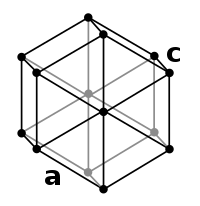
Photo from wikipedia
Abstract Nanostructured black Si materials prepared by metal-assisted wet chemical etching (MaCE) using HF to drive the nanostructuring, have emerged as excellent light-harvesting materials for solar water splitting. Recently, their… Click to show full abstract
Abstract Nanostructured black Si materials prepared by metal-assisted wet chemical etching (MaCE) using HF to drive the nanostructuring, have emerged as excellent light-harvesting materials for solar water splitting. Recently, their remarkable solar-to-hydrogen conversion capability was attributed to their surface oxidation mechanism. However, the same mechanism inhibits the interfacial kinetics within hours, and therefore they are deemed not suitable for a fully-functional hydrogen generating cell. Herein, we investigate the performance and interfacial kinetics of solar-to-hydrogen fuel conversion on black Si photocathodes that, for the first time, are free of any metal catalysts. We developed a near 100% metal-free Si interface by a HF-free etching approach. Systematic analysis and optimization of the nanostructure morphology and photoelectrochemical procedures supported continuous photoelectrochemical hydrogen generation for ∼250 h, involving −1.18 × 104 C.cm−2 of charge transfer at overpotentials as low as −0.2 V vs. RHE. We find that this high-performance of bSi makes it attractive as a green solar-to-hydrogen platform.
Journal Title: Electrochimica Acta
Year Published: 2017
Link to full text (if available)
Share on Social Media: Sign Up to like & get
recommendations!